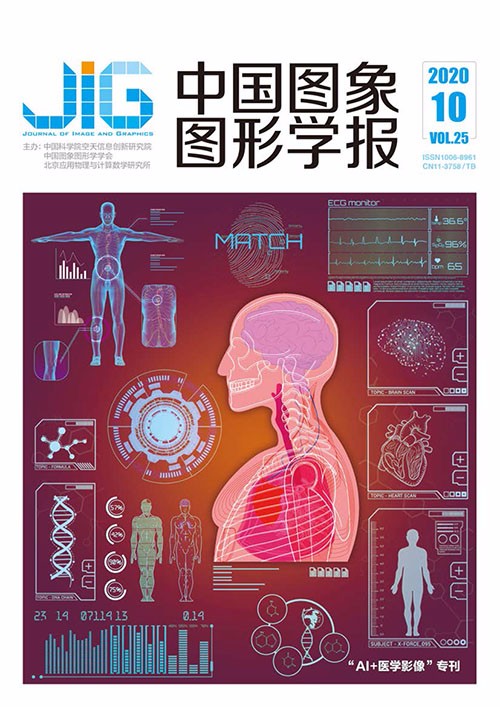
密集挤压激励网络的多标签胸部X光片疾病分类
摘 要
目的 X射线光片是用于诊断多种胸部疾病常用且经济的方法。然而,不同疾病的位置及病灶区域大小在X光片上差异较大且纹理表现存在多样性,是胸部疾病分类任务面临的主要挑战。此外,样本数据类别不平衡进一步增加了任务的困难。针对以上挑战以及目前算法识别精度有待提升的问题,本文采用深度学习方法提出一种基于密集挤压激励网络的多标签胸部疾病分类算法。方法 将挤压激励模块同样以密集连接的方式加入密集连接网络中作为特征通道高度注意模块,以增强对于网络正确判断疾病有用信息的传递同时抑制无用信息的传递;使用非对称卷积块增强网络的特征提取能力;采用焦点损失函数,增加难识别疾病的损失权重而减小易识别疾病的损失权重,以增强网络对难识别样本的学习。结果 在ChestX-ray14数据集上的实验结果表明,本文算法对14种胸部疾病的分类精度较目前3种经典及先进算法有所提升,平均AUC(area under ROC curve)值达到0.802。另外本文将算法模型在诊断时依据的病灶区域进行可视化,其结果进一步证明了模型的有效性。结论 本文提出的基于密集挤压激励网络的多标签分类算法,在胸部疾病识别上的平均AUC值较高,适用于胸部X光片的疾病分类。
关键词
Multilabel chest X-ray disease classification based on a dense squeeze-and-excitation network
Zhang Zhirui, Li Qiang, Guan Xin(School of Microelectronics, Tianjin University, Tianjin 300072, China) Abstract
Objective The task of classification of chest diseases is an important part in the field of medical image processing. Its purpose is to assist professional doctors to make accurate diagnosis and treatment through a computer automatic recognition system, which has important significance and role in clinical medicine. Medical image technologies play an important role in the recognition of chest diseases. They can provide doctors with clear internal textural and structural information. X-ray is a common and economical method for the diagnosis of various chest diseases. However, the main challenges in chest disease classification are that the location and size of the focus area of various diseases are different on X-ray films and the texture performance is diverse. The imbalance of sample data categories increases the task difficulty. Visual fatigue and other problems caused by long-term work, even for trained professional doctors, missed diagnosis, and misdiagnosis are also inevitable. Therefore, determining how to classify chest diseases automatically and accurately has become a popular topic in the field of medical image processing. At present, researchers mainly use the deep learning method to train a convolutional neural network to identify chest diseases automatically, but the overall recognition accuracy is inadequately high. Most methods cannot utilize the information on the feature channel. In view of the abovementioned challenges and the necessity to improve the recognition accuracy of current algorithms, this paper proposes a multilabel classification algorithm for chest diseases based on a dense squeeze-and-excitation network by using the deep learning method. Method First, to utilize the information on the channel of the feature map, we add a squeeze-and-excitation module to DenseNet densely as the high-attention module of the feature channel; hence, the network can fully consider the feature information of each disease. In the process of network propagation, the network can enhance the transmission of useful information for the correct judgment of disease types and inhibit the transmission of useless information. Second, given that the parameters on the convolution kernel skeleton, i.e., the central cross position, are important and the ordinary square convolution kernel is random at the time of initialization, the ordinary square convolution kernel may be optimized in a direction that is not to strengthen the skeleton parameters. We use an asymmetric convolution block to replace the ordinary square convolution kernel, highlight the role of the parameters on the central cross position of the convolution kernel, and improve the feature extraction capability of the entire network. Lastly, considering that each disease sample data in the data set is relatively different and the learning difficulty also differs, this paper adopts the focal loss function to increase the loss weight of difficult-to-identify diseases and reduce the loss weight of easy-to-identify diseases. The network will pay more attention to the learning of the difficult-to-identify samples by using the focal loss function to improve the learning capability of the network for the types of difficult-to-identify diseases, improve the overall recognition accuracy of the network for chest diseases, and reduce the accuracy differences. Result We conduct experiments on the large multilabel dataset ChestX-ray14, which was published by National Institutes of Health(NIH). The experimental results show that the average recognition accuracy of the proposed algorithm for 14 chest diseases is higher than that of three existing classic and advanced algorithms, and the average area under ROC curve(AUC) value is 0.802. Meanwhile, the recognition accuracy of this algorithm is improved to some extent for some difficult-to-identify chest diseases. In accordance with the gradient-weighted class activation mapping algorithm, we can generate the heat map of the focus area and visualize the focus area of the chest disease classification algorithm model in the process of disease diagnosis. Comparison demonstrates that the positioning of the focus area in the hot map is basically consistent with the marking frame given by professional doctors. This finding proves the validity of the model, provides a visual explanation for disease diagnosis, and helps gain the trust of professional doctors for auxiliary diagnosis. Conclusion In this paper, a multilabel classification algorithm based on a dense squeeze-and-excitation network is proposed for the recognition and classification of chest diseases. The experimental results show that our model is superior to several state-of-the-art approaches, with a higher average AUC value and stronger ability to diagnose some diseases that are difficult to identify. Our model is suitable for the classification of diseases and the recognition of chest X-ray images.
Keywords
chest X-ray multi-label classification densely connected network disease diagnosis medical image processing
|



 中国图象图形学报 │ 京ICP备05080539号-4 │ 本系统由
中国图象图形学报 │ 京ICP备05080539号-4 │ 本系统由